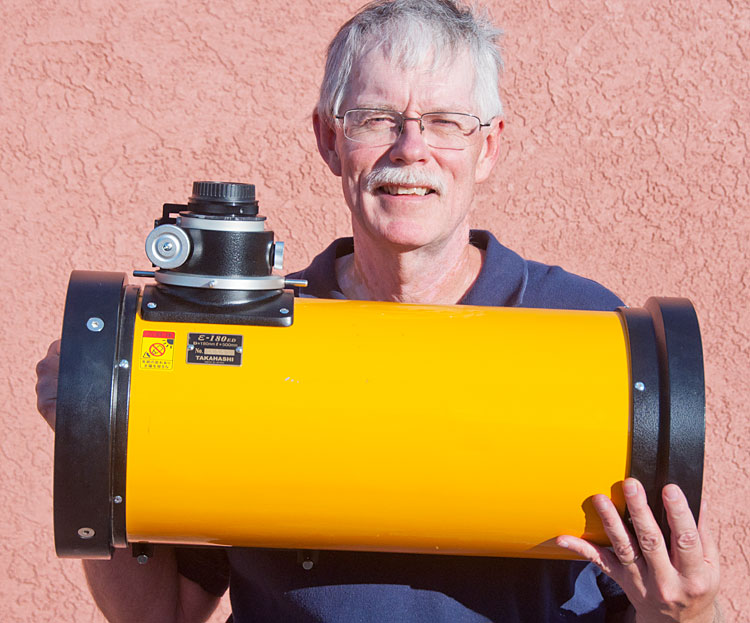The construction and most of the finish work on Bifrost Astronomical Observatory was completed in late 2009. Over the Christmas holidays, I installed the Astro-Physics 1200GTO German equatorial mount on the 6-foot tall steel pier I had purchased from ASV neighbor David Churchill. Using a triad bar and dovetail cradles purchased from Robin Casady Astro Accessories, I mounted the Astro-Physics 130mm StarFire EDF Refractor on the AP 1200GTO.
First Light in the new observatory took place on the evening of Jan. 1, 2010. In attendance were eclipse chasing friends Greg and Vicki Buchwald, Dave and Jean Kodama, and my wife Pat. During a short ceremony commemorated with champagne, the observatory was christened Bifrost Astronomical Observatory, the name honoring the fabled Rainbow Bridge Bifrost from Norse mythology that links Earth to Heaven.
It was now time to start considering a larger telescope for wide field imaging. I was quite intrigued by the HyperStar modification to Celestron and Meade SCTs.
While investigating these instruments and considering my options, I stumbled across a used Takahashi Epsilon 180 ED Hyperbolic Astrograph on Astromart an online classified ads service. My ASV neighbor Rick Beno owns one of these instruments. I visited Rick to see his Tak E-180 and he showed me some of his work with it.
The Takahashi Epsilon 180 ED Hyperbolic Astrograph (OPT) is quite an impressive instrument. It has an effective aperature of 180mm and focal length of 500mm. This gives it a very fast f/2.8 focal ratio. The optical system is a compound Newtonian telescope consisting of a hyperbolic primary mirror of 190mm aperature. The oversized rotating focuser assembly houses an extra-low dispersion (ED) two element corrector providing incomparable contrast and sharpness. The system produces 10 micron star images across the super-flat field of the entire 44mm (1.7") image circle. This large enough to cover a 35mm full frame CCD chip.
With this information in hand, I contacted the seller on Astromart who turned out to be Don Goldman (AstroDon). He told me the telescope was in excellent condition but he just wasn't using it anymore. The price was right and I saved over $1000 on the scope with included adapters, tube rings and mounting plate.The following table give the technical details for the Tak E-180.
| Takahashi Epsilon 180 ED Hyperbolic Astrograph Specifications | |
|---|---|
| Hyperbolic Primary: | 190mm (7.48") |
| Clear Aperture: | 180mm (7.09") |
| Secondary Mirror: | 80mm (3.15") |
| Central Obstruction: | 44% |
| Focal Length: | 500mm (19.7") |
| Focal Ratio: | f/2.8 |
| T/Stop: | f/3.1 |
| Resolution: | 0.64 arc seconds |
| Image Circle: | 44mm (60% not vignetted) |
| Corrector: | Extra-low dispersion two element corrector produces flat field images with no coma or chromatism |
| Focuser Type: | Low profile Crayford rack-and-pinion focuser; fully rotating for framing; provides 56mm of backfocus |
| Photographic Assembly: | M54mm female on the corrector (for wide T-mount) |
| Tube Dimensions: | Length = 570mm (22.4"); Diameter = 232mm (9.13") |
| Weight: | 23.6 lbs. (10.7 kg) |
Although I'm very happy with the Tak E-180, I had serious problems acquiring good images in the beginning. See Collimating the Tak E-180 for all the details.
In 2011, I used the Tak E-180 to image all 110 objects in the Messier Catalog. Visit the Messier Catalog Photo Gallery to see how well the Tak E-180 performs.
